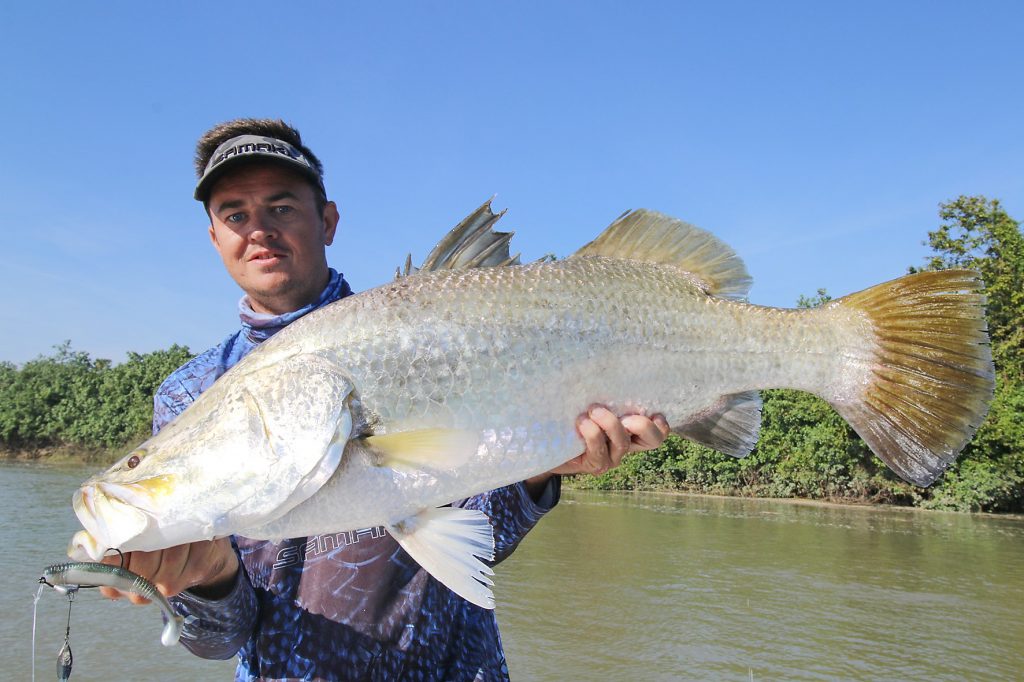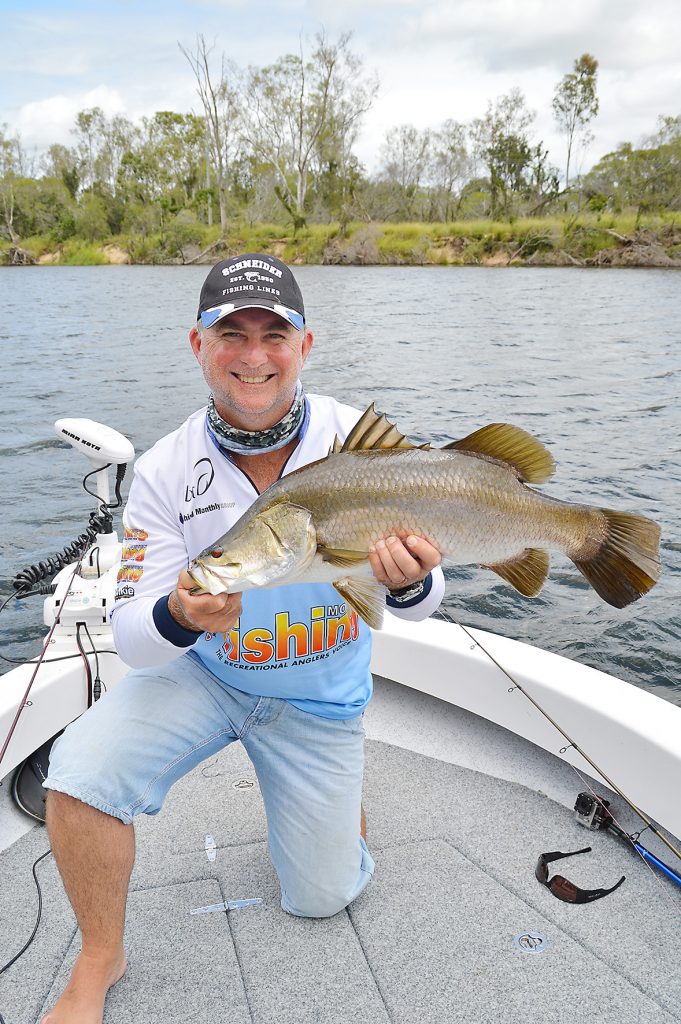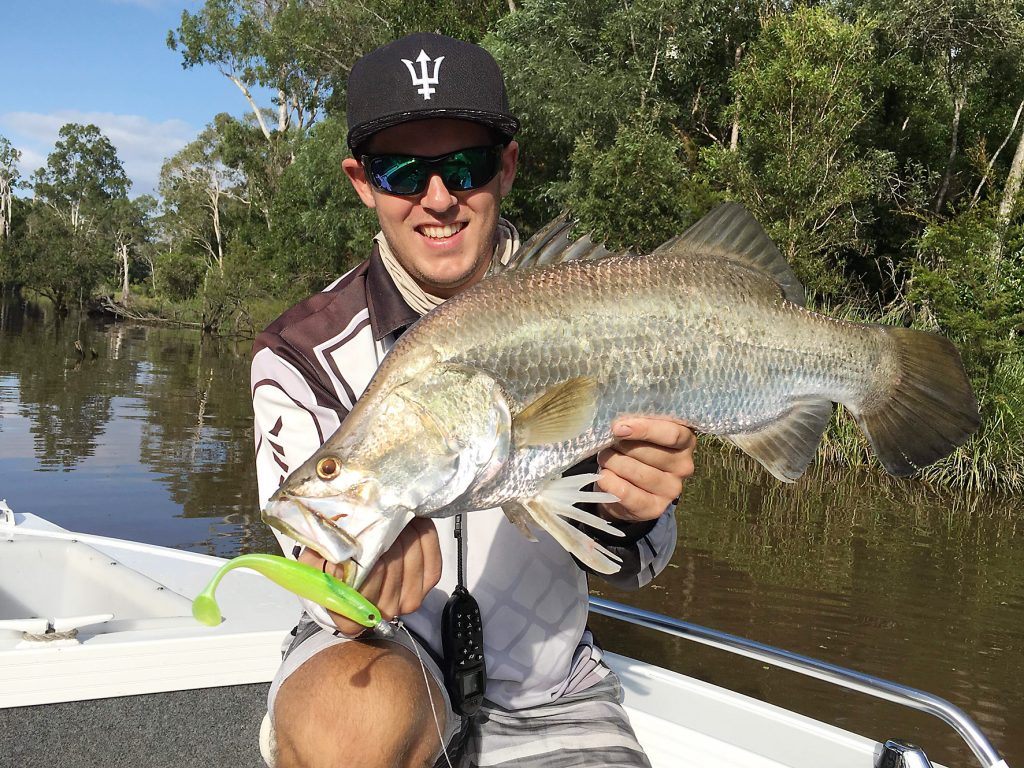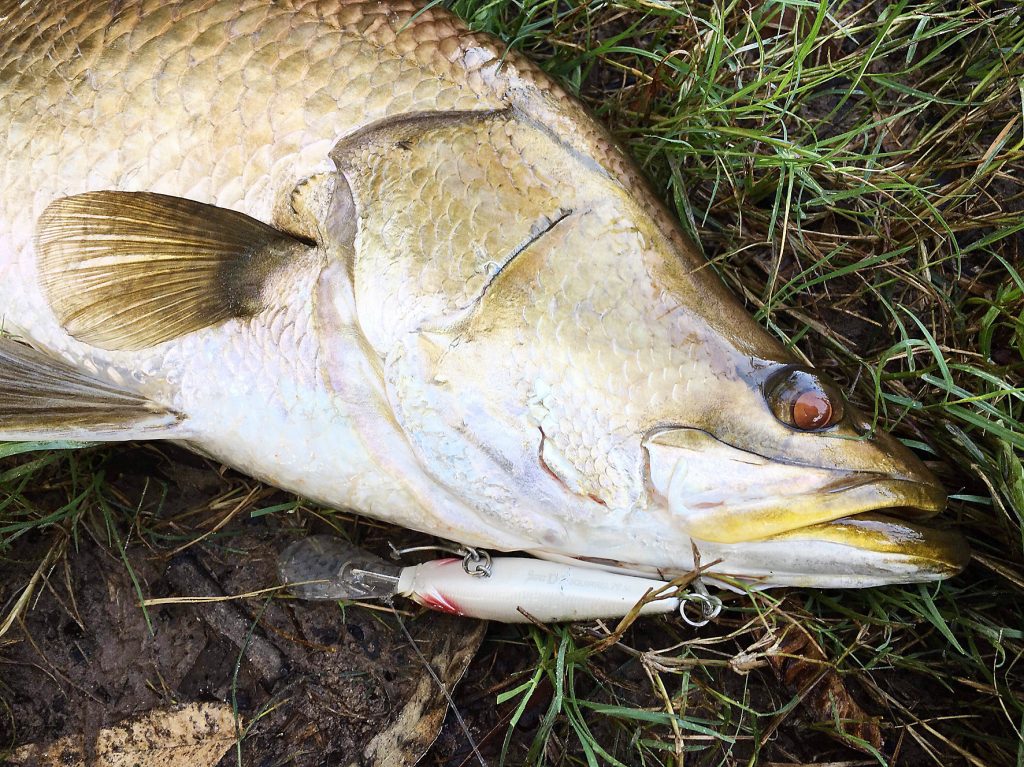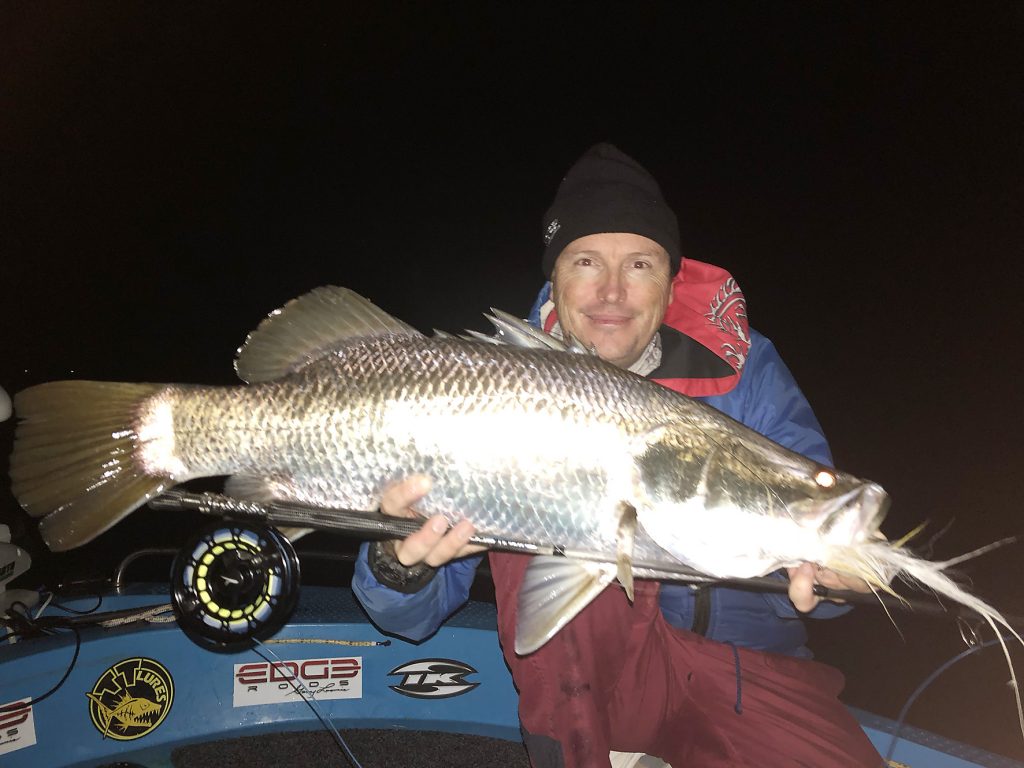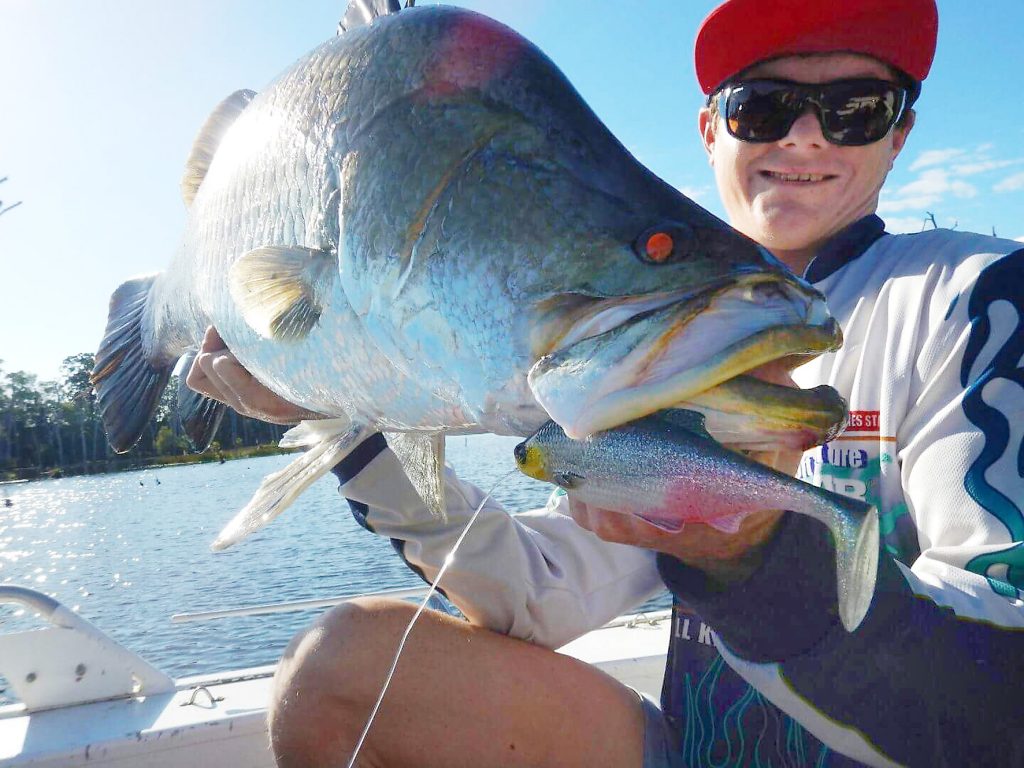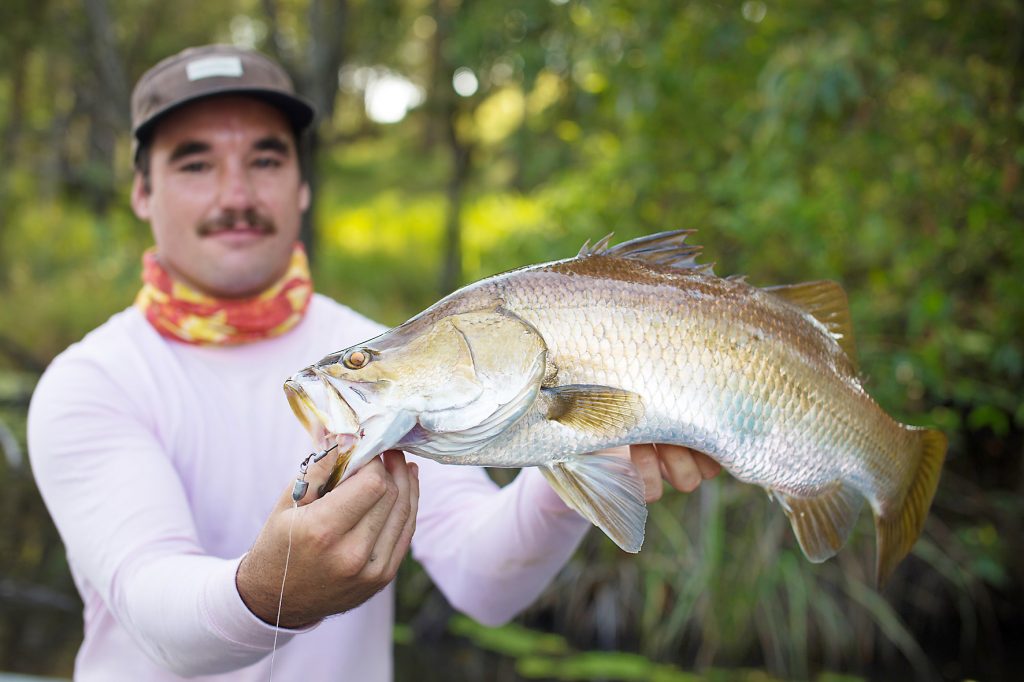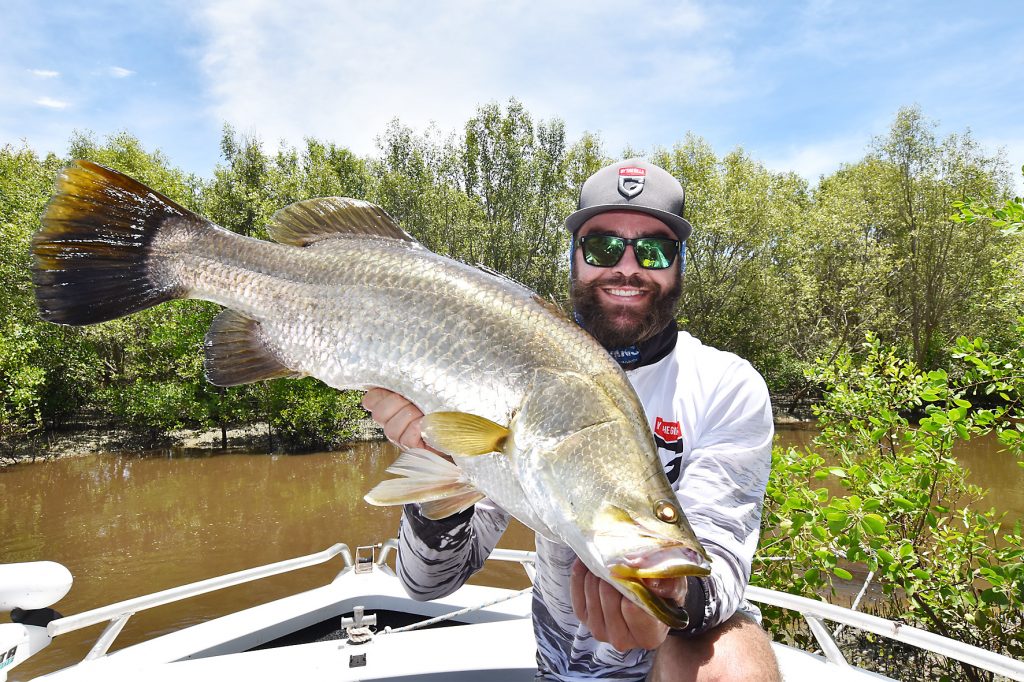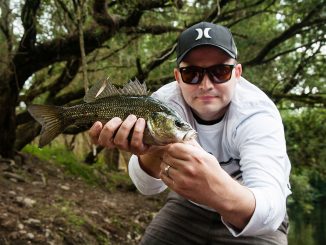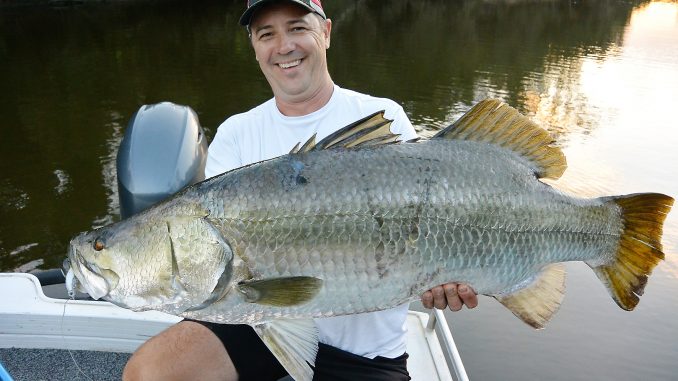
by Rupe •
Statistics from the revamped Fishing Monthly website have told us that you guys are lapping up every feature we’ve run over the past year about must-have lures for certain species like bass, cod or trout. Steve Morgan’s piece about crab lures was also a huge hit.
Now, with so many people hitting the QLD impoundments and rivers since barra open season kicked off in February, I decided the time was right to start on a new article: ‘mundi magnets.
In this feature I’ll go through most of the bigger categories, and why and when you should use them. I’ll also cover the techniques for each, and offer up a 6-pack of my personal favourites. Just beware though, if you go and catch a mega mundi on something from my one of my 6-packs, you in turn owe me a 6-pack of Great Northern Original – it’s the lure law, and it must be respected.
THE HARD STUFF
I reckon hardbodied lures for barra is one of the only lure categories in Australia that would actually be dominated by home-grown designs. Perhaps that’s because we’re an innovative lot, and our relaxed Aussie lifestyle has given us plenty of time to tinker with things and make the lures that our fishing forefathers needed. Or maybe these lures were born out of necessity, with early international offerings being too flimsy for the rigours of the mighty ‘mundi.
Either way, Australians have made some really great lures for one of our most iconic sportfish and we should celebrate those guys who inhaled all those paint fumes in the quest for better lures.
Trolling lures

Lots of people like to beat down trolling, but the numbers speak for themselves. So many fish have been accounted using this method, and it’s not as easy as you may have been lead to believe, particularly in flowing water. Many of the rivers that hold barra have raging flows and ever-changing underwater landscapes. It’s no mean feat for the captain to steer not only his boat but also any number of rods with lures in the water that might be 40ft behind the boat in and out of snags, rock bars or man-made structures.
The ideal barra trolling lure is anywhere from 100-180mm long with a bib to suit the depth of water you’re likely to be fishing. If you were to gauge popularity by just the numbers that appear on tackle shop walls, you’d find that 120mm long and diving to 10ft deep is what they sell the most of, which of course translates to that combo also catching the most fish. Narrow, pointed bibbed options will give you a very high cycle rate while shorter, rounded front bibs give the lure a slower cycle rate, with more of a roll at the top of its action.
Because of the typical length of the lure, you’ll usually find they have three sets of trebles. However many trebles they have though, always either choose a lure with the appropriate level of strength in its hooks and rings, or retro-fit your own before you hit the water. Don’t allow yourself to be let down by cheap terminal tackle.
While you’ll find them in thousands of weird and wonderful colour combinations, if I had to survive using only three I’d pick Guns N Roses, chrome gold and bleeding mullet to put food on the table.
Technique
When trolling, set your lures anywhere from 15-40ft behind your boat and slow your motor down as much as you can. Plot your course along the outside of weed beds or standing groves of timber, or weave your way in and out of other structure as best you can. Don’t be afraid to hit the bottom every now and then, but adjust your course and depth by feel and using your sounder.
It’s not a bad idea to ask the kids for a lure retriever for Fathers Day either. You’re going to need it if you want to keep your lures where the big bruisers live!
Rupe’s barra trolling 6-pack
- Classic Barra 120 10+
- Bomber Long 15A HD
- Rapala X-Rap SXR10
- RMG Scorpion 150
- Storm Thunder Barra
- Zerek Tango Shad 120
Casting Lures
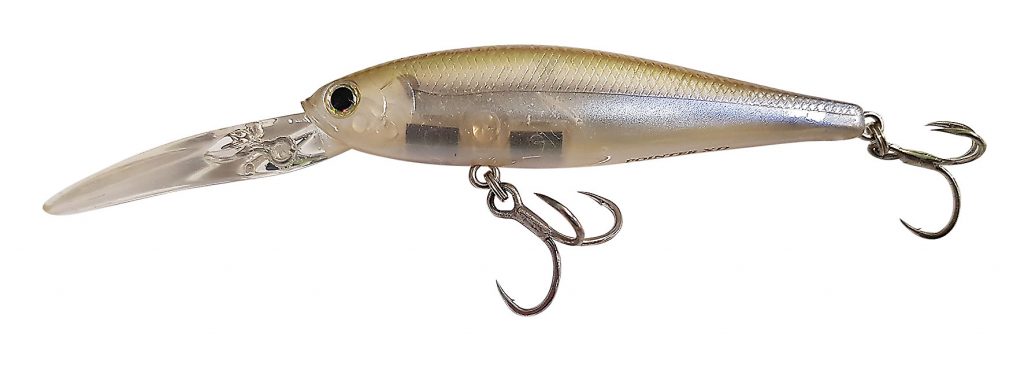
While all lures can be either cast or trolled, there are certainly preferred applications for individual types or styles. This means that while you don’t need to buy both casting and trolling hardbodies, it’s a good excuse to do so.
The casting lures aimed at the barra market have so much variation to them. There’s quite a bit of crossover from both international markets and also from designs aimed at other Aussie natives, such as bass, cod or mangrove jacks.
Generally these lures will be shorter than their trolled counterparts, and manufacturers can get creative by making floating, sinking, suspending, rattling and silent versions of the same lure. More lures for the tackle box – yay!
Start with lures from around 70-110mm long and, if you can afford to by a few, mix it up with colours, float types and sounds. You just don’t know what will turn the fish on.
Typically the bibs on these lures are a bit longer, to provide instant resistance in the water so they can dive to the desired depth quickly. You want them to get down low and go-go-go, twitching their way through the branches of submerged timber or bouncing between rocks and logs.
There have been quality Aussie-made lures for throwing at creek mouths and the like since the Godfather of lure making down under, Eric Moller, carved and modelled his own take on the famous Heddon Tiger. This kind of Aussie innovation won’t be slowing down any time soon, but there’s also a range of quality imported jobs that have been beefed up to include ‘Heavy Duty’ options. Lucky Craft and Jackall have done it better than most, with their Pointer AU and Squirrel Hank Tune series respectively. The level of engineering from these Japanese manufacturers is breathtaking if you’re a lure tragic like me.
Technique
Techniques for this style of lure vary quite a bit, and can be unique to different locations. For suspending lures in particular I’d suggest a jerk-jerk-pause action, and the longer you can pause, the better. I’m an impatient angler so it’s always a struggle for me to let the lure sit there but trust me, the longer it sits the closer you are to hook-up.
Too often we can get caught up travelling a bank, casting directly into snags that look ‘fishy’. However, I can offer one piece of advice that I’ve ignored far too often while watching my deckies slay fish after fish: don’t get caught up in what’s next to the boat. Instead, cast forward of the bow as much as you can. The element of surprise is your friend, and even if your boat is a stealthy one it can still count against you.
Rupe’s barra casting 6-pack
- Lucky Craft Pointer AU Series 78XD
- Jackall Squirrel 79 Hank Tune
- Zerek Tango Shad 120
- Atomic Hardz Shiner 85
- Rapala Shadow Rap
- DUO Realis Jerkbait 100SP
THE SOFT STUFF

I can remember walking into the tiny old version of Fishing & Outdoor World in Darwin one otherwise ordinary day when I lived in the NT, and seeing owners George and Ronald clearing space for tubs upon tubs of soft plastic lures that had just arrived. There were some cool lures from US makers like Renosky and Manns, as well as an Australian model called a ‘Squidgy’.
“What the *bleep* is a Squidgy?” I asked.
It was explained to me that these were the next best thing in barra fishing. Stupidly I dismissed it as being a flash in the pan, and something that would come and go quicker than the bottle of 15-year-old scotch I’d bought the old man for his birthday. Looking back on that day 16 years ago, I couldn’t have been more wrong.
Nowadays there are just as many quality soft plastics available as there are hardbodies, possibly even more. The amount of places you can throw them and the ability to customise colours, weights and impart actions means if you haven’t got soft plastics in the boat you’re really limiting your ability to land a barra.
Because plastics are relatively cheap you might be able to afford more variety in your soft plastic box than you can with hardbodies, vibes or topwaters. Depending on the waterway you’re fishing, the typical food source size and also the size of barra you think you’re likely to encounter, I recommend starting with 4” models and work up from there. In saying that though, a 50cm barra will try to eat a 9” plastic, and a 120cm fish will happily eat a 4” bait if you put it in the right spot.
Technique
Paddle-tail models dominate the barra offerings, and with good reason. They provide constant flash and movement during the retrieve, and the resistance from the tail slows the plastic down too. Just like a scene out of a crappy teenage movie where the insanely hot chick slowly walks away from the loser kid pining, that’s how it works for barra chasing soft plastics. Keep it nice and slow and let the fish enjoy that shake until they can’t bear it anymore and steal a kiss.
Rupe’s soft plastic 6-pack
- Castaic Jerky J Swims 7”
- Samaki Boom Baits Bomb Shad 6”
- ZMan SwimmerZ 7”
- Holt Productions Swim Prawn
- Keitech Swing Impact Fat 6.8”
- Squidgies Slick Rig 130mm
VIBES
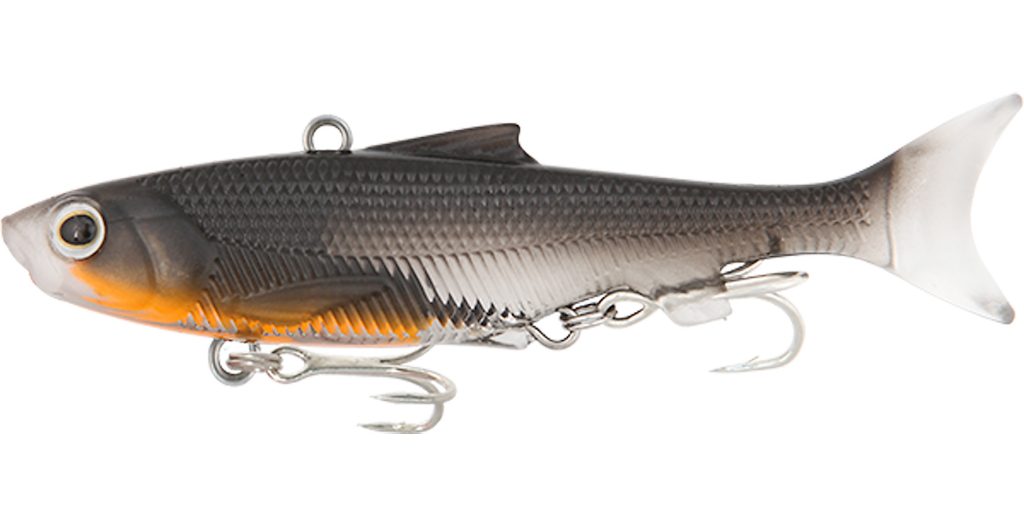
This is a style of barra fishing that I personally haven’t had a lot of success with, but I have seen it bring so many big chromies over the rails I’ve lost count. Vibes are very effective in deep, saltwater situations, and the approach is simple: long casts, slow retrieve, hang on and try not to get dusted.
Through a combination of weight and clever design, vibes offer the angler at the other end of the line the opportunity to keep their lure in the strike zone for a long period of time, and also maintain consistent action with very little input from the rod. Don’t get me wrong, you can work the lure by hopping, jigging or burning and killing as much as you want, but it’s not necessary for them to be effective.
You can get vibes in either soft or hard forms, and they come in every colour of the rainbow with different sound types and sink rates. Some of the translucent fish patterns available now look as close to a real baitfish as you’re going to get.
Whichever model you chose, try to get one with a through wire from tow-point to hook hangers. That way, even if everything goes wrong and a lure hits the self-destruct button, you’ll still get the fish. I would happily donate any lure I own to hold a metre of ‘mundi.
Technique
When using vibes for any species I like to vary my method. You shouldn’t change it up too often, but rather employ a ‘search and destroy’ tactic, particularly when you can see fish schooled up or huddled around structure on a sounder. At times like this, vibes really come into their own. Most vibes are aerodynamically built so you can cast them a mile, and then just present the lure to the fish in different ways until you work out what they’re craving that day. Sometimes low and slow will do the trick, while at other times you’ll need to almost violently hop them through the water column to trigger the strike.
Rupe’s barra vibes 6-pack
- Samaki Vibelicious 100 Fork Tail
- Madness Shiriten Vibe
- Samaki Vibelicious 125 Thumper Tail
- Jackall Transam 95
- Zerek Fish Trap 110
- Mazzy Vib Forte
TOPWATER

Catching barra of any size in any way is a joy. They’re fast, explosive and often acrobatic during the fight, but if you can get them to eat a lure off the roof then the excitement increases dramatically.
Just looking at the basic anatomy of a barra you can see they’re almost built for stalking from below, and exploding on prey that sits just below or even above the waterline. Can you imagine just how nervous a frog must get in the time it takes to kick its legs three times getting from one lily pad to the next? It must be exhausting, but that’s precisely where the fun starts for the angler!
We’ve now had enough mad scientist lure makers around the globe to make a huge assortment of topwater lures, many of them closely mimicking actual food sources, that we can pick and choose from. Looking at that long list of lures is like selecting from the menu at KFC – you know EVERYTHING is delicious but what do you feel like today? Do you want something that crawls like a wounded bird or rodent, spits and splutters like a busted baitfish, or hops through the lilies like a frog?
More to the point, what does Mr Barry Mundi want to eat today?
Technique
Fizzers and frogs are my favourite when it comes to surface fishing, and I make my choice between those dependent on where I’m casting. If it’s a creek mouth or standing timber with little chance for obstruction I’ll throw a fizzer and go for a burn-and-kill style retrieve. Fizzers throw plenty of water and usually have at least a couple of trebles depending on body length, which helps with hook-up rates.
If I get the opportunity to throw directly over a weed bed or grove of lilies I’ll opt for the frog every time. Most are built on upward facing double hooks, and are weighted to skip and skim over the surface of the lilies and drop into the space between, giving fish the opportunity to eat them. This design means they are very much a weedless lure most of the time, but you can suffer from poor hook-up rates, especially with the smaller class fish you find in some of the freshwater below the Queensland impoundments.
Rupe’s topwater 6-pack
- Bill’s Bugs Fuzz Bugs 100mm
- OSP Bent Minnow 106
- Teckel Sprinker Frog
- Rapala Skitter Pop
- Lunkerhunt Popping Frog
- Owner Tango Dancer 95
SWIMBAITS AND GLIDEBAITS
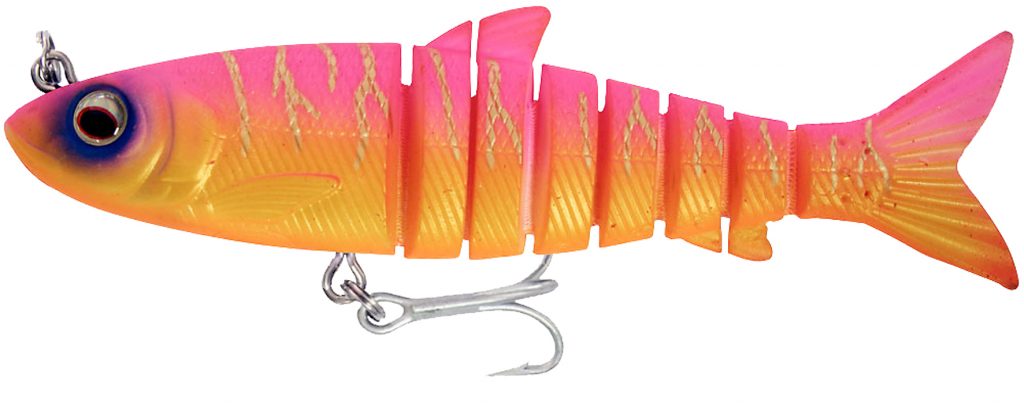
No tackle box is complete these days without the addition of swimbaits and/or glidebaits. These versatile offerings can present lures in such a realistic fashion that you could be forgiven for mistaking your own lure for a baitfish. Just like vibes, there are hard and soft options on the market, and both will do the job for you if used in the right spot in the right way.
Technique
I like to cast swimbaits out along edges, let them sink to around the mid-water mark and slowly retrieve from there, with a few pauses thrown in for good measure. When throwing glidebaits I’ll use them in the same areas but with a much longer pause and a big sweeping rod action to let them dart and dive as they sink. Give the lure some slack line when you can, it will give it more freedom and it will dive through the water with an even more life-like action. If you’ve ever seen a video of a school of sardines being swiped at by angry billfish, you’ll know that there are always a few that get stunned in the rush, and they sort of float and tumble away from the school. That’s the action I’m looking for in my glidebait, hopefully offering a nice easy meal for big bad Barry and his mates.
Rupe’s swimbait/glidebait 6-pack
- Zerek Live Mullet 5.5”
- Evergreen ES Flats
- Chilton Tackle Co RAY 145
- Swimbaits Australia 150mm Glidebait
- Lucky Craft Real BG 150SS
- Castaic BD Shad
ON THE FLUFF
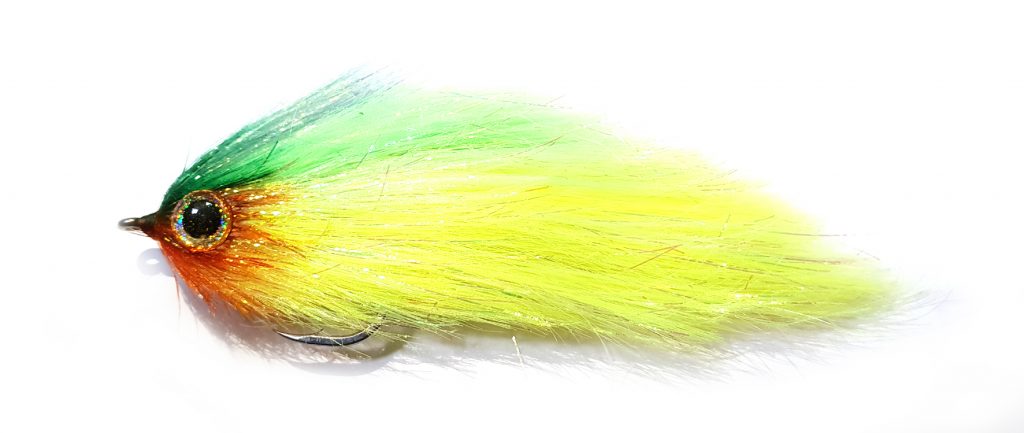
Having never actually attempted to catch a barra on fly, I had to do a bit of ringing around in order to make sure I didn’t miss out on the vital info for this article. Speaking to a few good mates, they all had many hints, tips and tricks to share, but one thing rang true across all conversations: don’t arrive undergunned. As the saying goes, you should never take a knife to a gun fight, and your gear had better be up to task or you may as well leave it at home.
Flyfishing itself is one of the purest ways someone can enjoy this great sport, but there is so much to do before you find, hook or even think about landing a fish.
Start with a fly rod in the 9wt, 10wt or 12wt bracket and an intermediate line. A shorter rod can help when trying to cast in tight situations, and will also help you steer a fish once connected.
You’ll need a mix of flies, from poppers and gurglers through to sinking flies like Clousers and legendary flyfisherman Lefty Kreh’s all time favourite – the Deceiver.
Like any lure presentation you’ll need practice, patience and a variety of presentations to crack the pattern on that particular trip, and it all may change before you go again.
Whether you’re fishing for barra or any other species, don’t be afraid to pick a fly rod up and have a go. It’s frustrating at first but it really is rewarding when you get it right.
Rupe’s phone-a-friend barra fly 6-pack
- Lefty’s Deceiver
- Gold Bomber Fly
- Pink Thing
- Dahlberg Diver
- Clouser Minnow
- Ammo Flies Game Changer
Nothing left to do but do it
If you haven’t caught a barramundi before, I hope this has given you a helping hand when considering what to throw, and encouraged you to venture out in search of them. And if you’ve already popped that cherry, hopefully this feature has given you a couple of options you haven’t considered before.
There’s a reason people travel from all over Australia and from all corners of the globe in search of barramundi. They’re an impressive fish and can create memories to hold on to forever.
Just do me one favour – the next time you’re out on the water, remember that nobody wins a prize for owning the most lures, so take a risk and make that cast into the impossibly thick snag. The fish of a lifetime could be eagerly awaiting the arrival of your sacrifice to the fish gods.
If the worst thing that happens is that you lose a lure and have to go into the tackle store to buy more, you’re still winning at life!
To keep up with Rupe’s fishing adventures or misadventures, follow along on Facebook and Instagram.
www.instagram.com/rupeisfishing
www.facebook.com/rupeisfishing

